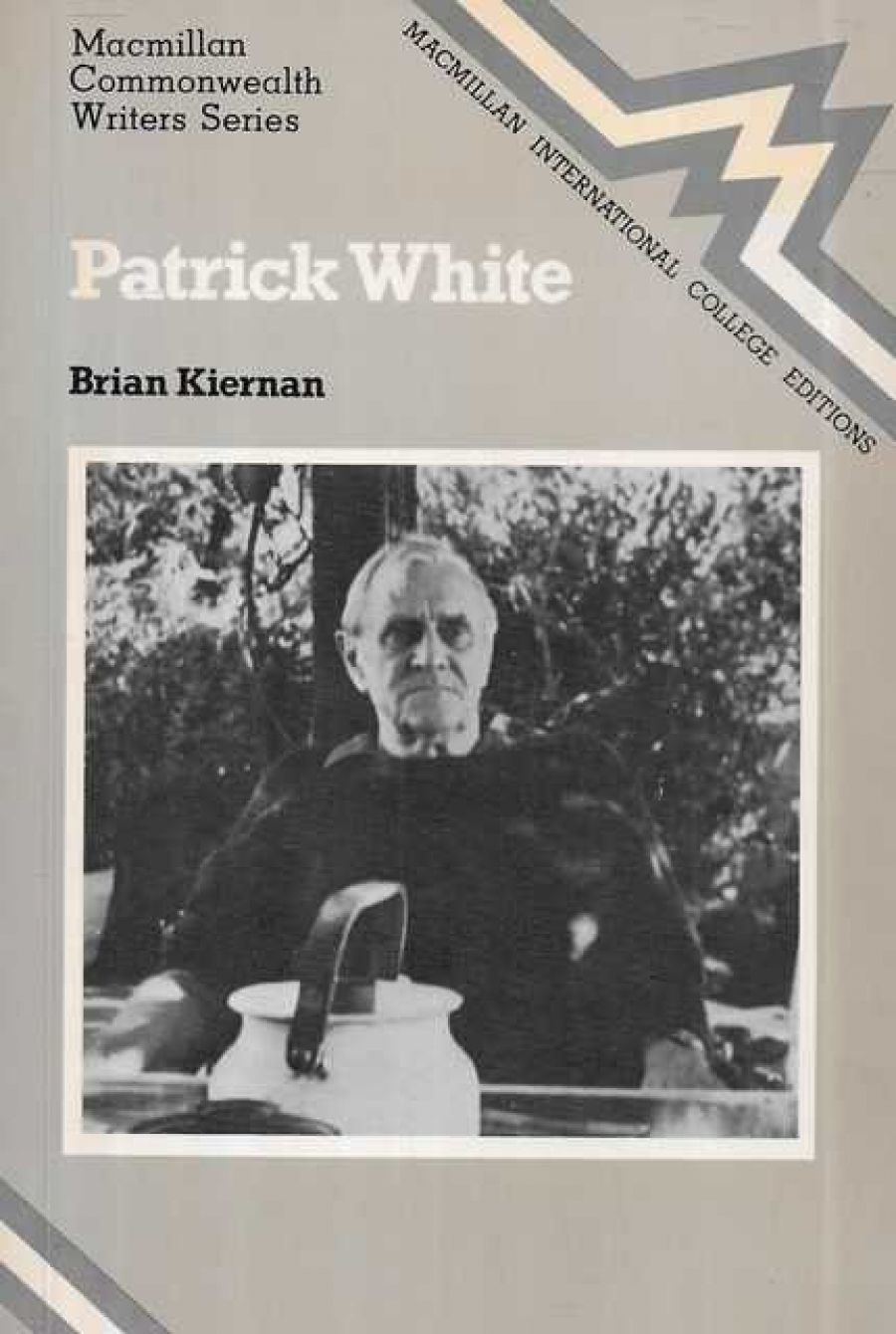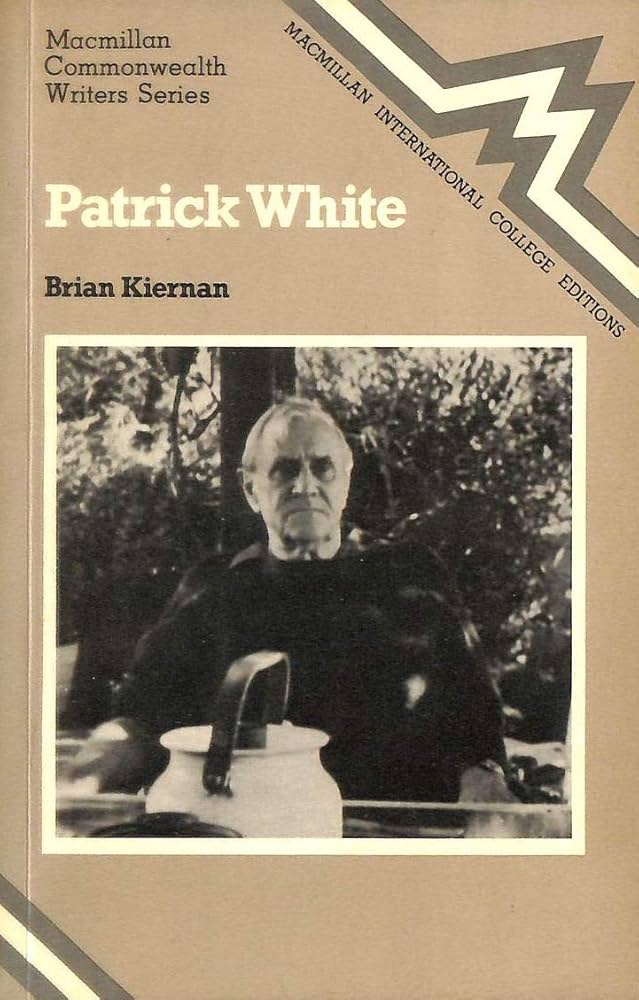
- Free Article: No
- Review Article: Yes
- Article Title: White Interpretations
- Online Only: No
- Custom Highlight Text:
Despite the title of the parent program, the aims of the Commonwealth Writers Series are not small. These paperback editions propose:
… a panoptic survey of a writer’s work, assessing its significance and merits, and conveying the critic’s enjoyment of the writer concerned, within a total length of between 96 and 176 pages. Each book will have a Survey chapter, placing the major works and events in the author’s life and times. - Book 1 Title: Patrick White
- Book 1 Biblio: Macmillan, $7.95 pb, 147pp
- Book 1 Cover Small (400 x 600):

- Book 1 Cover (800 x 1200):

Kiernan’s interest in the ‘historical cultural context as well as the local, temporal and universal aspects of White’s work’, along with the simultaneous tracing of critical reception, provides an overview that in part owes its strength to a retrospective reassessment of some solid critical studies (general introductions to White’s work by writers like Dutton, Brissenden, Argyle and Walsh or more specific analyses e.g., Herring and Colmer). But it is the balance of Kiernan’s critical stance that makes this breadth of vision significant. His method of creative assimilation rather than critical assassination places him in the enviable position of being able to wisely and unembarrassedly note that ‘White the novelist is less absolute than his critics’.
The format is as predicted an introductory chapter (biography, social setting and some hints for future biographers) followed by four chapters covering the work from the 1930s –40s through to the 1970s (necessarily omitting The Twyborn Affair but admitting the early poetry). There is a short but precise summary and a select bibliography. But this is not simply a deft or competent romp through the verbal intricacies of the White canon. The chronological rather than generic approach to the work permits some valuable cross-fertilisation of ideas – comparisons between characters, settings and structures of the stories, novels and plays. The integration of textual explication and critical evaluation is smoothly achieved, while assessments of developing style emerge fairly naturally from the discussion of work and influence. For example, Kiernan notes:
The contrast between essence and existence, and the irony generated through perceptions of the ideal manifesting itself in drab actuality pervade The Aunt’s Story and provide the procedure for the ‘narration’ of Theodora’s early life. It is less a traditional narration and more a dramatic presentation of a succession of perceptions embodied in images and incidents.
It is not a new observation that this novel’s narrative style owes something to Joycean technique, but Kiernan’s concept of dramatic presentation’ is enlarged throughout the study as he develops a thesis linking linguistic play with dramatic irony and offers a revaluation of White’s methods in terms of dramatic effectiveness. Perceiving White’s use of language as essentially ‘poetic’ Kiernan suggests that his irreverent ‘clashing of modes’ (those disconcerting shifts between the ‘real’ and the surreal or the physical and the metaphysical that has evoked a rash of critical irritation), the moments of linguistic excess or overt simplicity, or the tendency towards the overly dramatic ‘gesture towards the ineffable’, should be appreciated within a context of experiment and a deliberate ‘play’ that results in White’s constant and valuable ‘capacity to surprise’. Infuriating ambiguity is reassessed as a ‘cultivation of uncertainty’ and becomes the means of artistic advantage rather than the ends of uncertain design. Kiernan observes that a story like ‘Clay’ from The Burnt Ones:
… anticipates a more general shift in the contemporary short story, away from the realistic fictions towards fantasy, parody and elliptical fable, and the exploitation of possibilities for imaginative and linguistic play.
The same sort of departure from convention is apparent in White’s contribution to the Australian theatre – the plays that more fully utilise the resources of language affording an imaginative liberation. The unfortunately ‘over-extended metaphor’ or the ‘portentous phrase’ does not kill Kiernan’s recollection of his excitement at the discovery of White’s work and the general plea for appreciation of artistry ‘within its context’ embraces a recognition of the importance of this artist’s work in the Australian cultural development. Kiernan sets overt literariness against poetic poignancy as he reconsiders the merits of The Solid Mandala, or admits the charge of ‘schematic presentation’ to weigh it against White’s capacity for ‘empathic curiosity’ in The Eye of the Storm – a far cry from the more usual mutterings about misanthropy. Kiernan considers the juxtapositions of ‘Lear-like drama’ with the ‘classic piece of comic staging as evidence of White’s sense of dramatic irony and communicates the arbitrariness of definitions like ‘novelist’ or ‘dramatist’. He also suggests that White’s interest in character (the exploratory distance between a Theodora at the centre stage and an Elizabeth Hunter at the ‘eye’ of artistic focus) is rather more involved than purely manipulative – an indication of an abiding interest in the world stage and its players:
While excesses in some directions need to be admitted, so also should the accompanying creative delight in exploring character beyond what is seemingly necessary for thematic development. Basil is the splendid super-abundant example.
The study does not neglect White’s characteristic concerns: the recurrent themes, presentation of dual levels of perception, epiphanies or alarming demonstrations of limited consciousness, the ‘parodic playfulness’, allegorical inclinations or the swift cut and thrust of White’s social satire. The coverage of the individual works is judicious but the use of the small scene like the Musto’s tennis party in The Solid Mandala or the Cheesman’s dinner party in The Vivisector (where Kiernan wryly notes that White is no more able to contain his spleen with these figures than the detergent knight his wind’) is inspired; not only entertaining but offering appropriate revelation. Kiernan claims that:
White’s novels are certainly not simple in their play with literary conventions, allusions, modes, and their linguistic density. In the sense that they are extremely complex, ambiguous and ironic verbal structures, they can be considered as ‘poems’ not easily amenable to and perhaps finally resistant to interpretative summary. There is a danger that attempts to respond to the poetic texture by close analysis of it will fail to establish a reading that is convincingly consistent with a total dramatic context…
With due regard to the proposed readership (secondary and tertiary students of literature in English) one hastens to add that this is not a convenient escape clause for slothful readers, but rather a pertinent warning to the budding critical vivisectionist whose grasp of partial magnification might simply limit the field. Speaking of wider vision Kiernan also suggests that:
White the novelist engaged with character is often at odds with the ‘thinker’ who has been abstracted from the fictional context and seen as projecting a rigidly dualistic view of life. Of White the novelist it can be said with certainty that through successive novels he can be found to be curious about and sympathetically warming to characters who we might have expected to draw his antipathy.
So much for cultural elites!
Kiernan asks that we recognise White’s dramatic engagement with life and that we value the struggle to convey an awareness of the multi-faceted nature of experience, without imposing narrowing perspectives. What’s more, he shows us how it’s done.


Comments powered by CComment